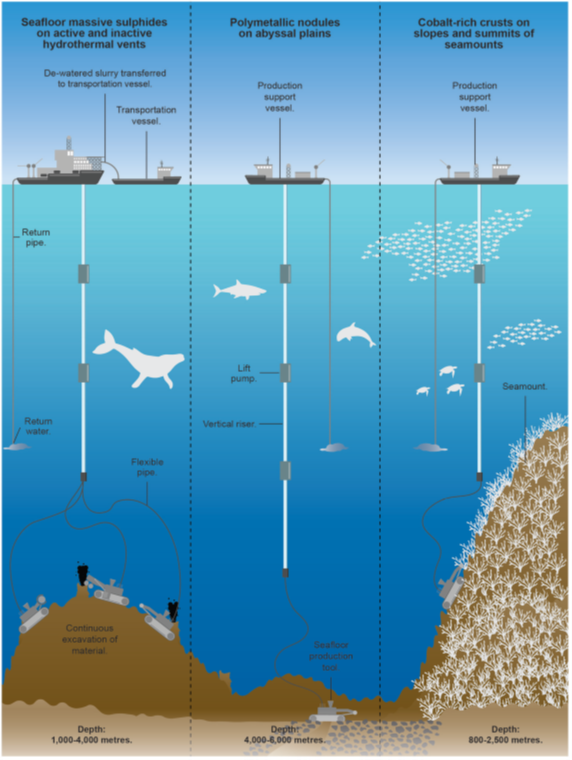Seabed mining: Environmental cost to meet demand for renewable energy technology
AEG Blog by William Godwin, PG, CEG. Past President of AEG
OPINION
Seabed mining: Environmental cost to meet demand for renewable energy technology
With the push to find rare earth and other metals necessary for battery storage and renewable technologies are we losing perspective of environmental consequences of our mining activities needed to extract these products? From my perspective as a geologist, the earth contains all the necessary raw products to allow humankind to enjoy life comfortably, have modest growth potential and still have resources available for generations to come. The earth however is not a limitless source and there are repercussions.
Efforts have begun to mine polymetallic nodules from the seafloor of the Northern Pacific Ocean. These nodules are rock concretions that harbor minerals like manganese, nickel, cobalt and copper.

A polymetallic nodule. Image Courtesy of the DeepCCZ expedition / NOAA.
There is huge market for these minerals to support technology, in particular in the manufacturing of batteries and storage devices. While deep-sea mining has not started in any part of the world, 16 international mining companies have contracts to explore the seabed for minerals within the Clarion Clipperton Zone (CCZ) in the Eastern Pacific Ocean, and other companies have contracts to explore for nodules in the Indian Ocean and Western Pacific Ocean. Since the CCZ lies within international waters, any mining in this region would be regulated by the International Seabed Authority (ISA), an intergovernmental body set up to oversee and control mining beyond any country’s jurisdiction. Companies wishing to mine in the CCZ also need to be sponsored by at least one nation in order to get a permit.
Several articles and peer-reviewed papers have been written recently on this subject. Chin and Hari (2020) have conducted an impartial review of literature to see what the environmental impacts might be for industrialized mining in this area. Dacey (2020) looks at this situation from both and economic and environmental standpoint. Miller et al (2018) explore three broad aspects relating to the exploration and exploitation of seabed mineral resources: (1) the current state of development of such activities in areas both within and beyond national jurisdictions, (2) possible environmental impacts both close to and more distant from mining activities and (3) the uncertainties and gaps in scientific knowledge and understanding which render baseline and impact assessments particularly difficult for the deep sea. The figure below shows a schematic of mining techniques that could be employed for extraction of sulphides, nodules and crusts.

Figure from Miller et al (2018)
A report by Deep Sea Mining Watch and MiningWatch Canada suggests that sediment plumes and waste discharge from mining could upset phytoplankton blooms at the sea’s surface, and introduce toxic metals into marine food chains. This mining waste could also travel through the ocean and damage nearby seamounts and coral reef systems, which many fish and marine mammal species depend upon for shelter and food, and put entire fisheries at risk.
From a purely economic point of view Nodule mining is one way to obtain the minerals needed for a global transition toward sustainable energy. There is growing demand for certain resources used in the production of wind turbines, solar panels and electric vehicles, according to a report by the World Bank. In fact, the report found that the production of minerals such as graphite, lithium and cobalt would need to increase by nearly 500% by 2050 to meet the growing demand for sustainable energy sources.
However, another study says research shows that the minerals required for renewable energy can be found in existing terrestrial stocks and accumulations of electronic waste, and that the development of circular economies makes seabed mining an unnecessary exercise.
A recent article by the BBC titled “Mine e-waste, not the Earth, say scientists” states that the recycling of e-waste must urgently be ramped up because mining the Earth for precious metals to make new gadgets is unsustainable. One study estimated that the world's mountain of discarded electronics, in 2021 alone, weighed 57 million tons. The Royal Society of Chemistry (RSC) says there now needs to be a global effort to mine that waste, rather than mining the Earth.
My feeling is that we are making a huge mistake if we authorize and allow mining companies to dredge the ocean floor to extract these minerals. The result will be damage to the seafloor, the marine life that it sustains and any chance of using as yet unfound resources or process that may be of a longer term benefit to human beings. Efforts to mine these resources from existing waste piles, stockpiles and other land-based mines is more sustainable and will have a much lower impact on the health of our planet.
If you are at all interested in this topic or mining in general, please submit an abstract and/or register for the upcoming virtual symposium titled “Life of Mine – Maintaining Sustainability Through Geoscience”. being sponsored by a collaboration between the Environmental and Engineering Geophysical Society (EEGS), the Association of Environmental and Engineering Geologists (AEG) and the American Society of Reclamation Science (ASRS). Please visit the symposium website.
References
Chin, A and Hari, K (2020), Predicting the impacts of mining of deep sea polymetallic nodules in the Pacific Ocean: A review of Scientific literature, Deep Sea Mining Campaign and MiningWatch Canada, 52 pages
Dacey, J. (2020), Deep-sea mining may have deep economic, environmental impacts, Eos, 101,
https://doi.org/10.1029/2020EO147683. Published on 03 August 2020.
“Mine e-waste, not the Earth, say scientists” by Victoria Gill, Science correspondent, BBC News https://apple.news/AwxI21R9cTxuMOA_d9lUyuQ
Miller KA, Thompson KF, Johnston P and Santillo D (2018) An Overview of Seabed Mining Including the Current State of Development, Environmental Impacts, and Knowledge Gaps.
Front. Mar. Sci. 4:418. doi: 10.3389/fmars.2017.00418
